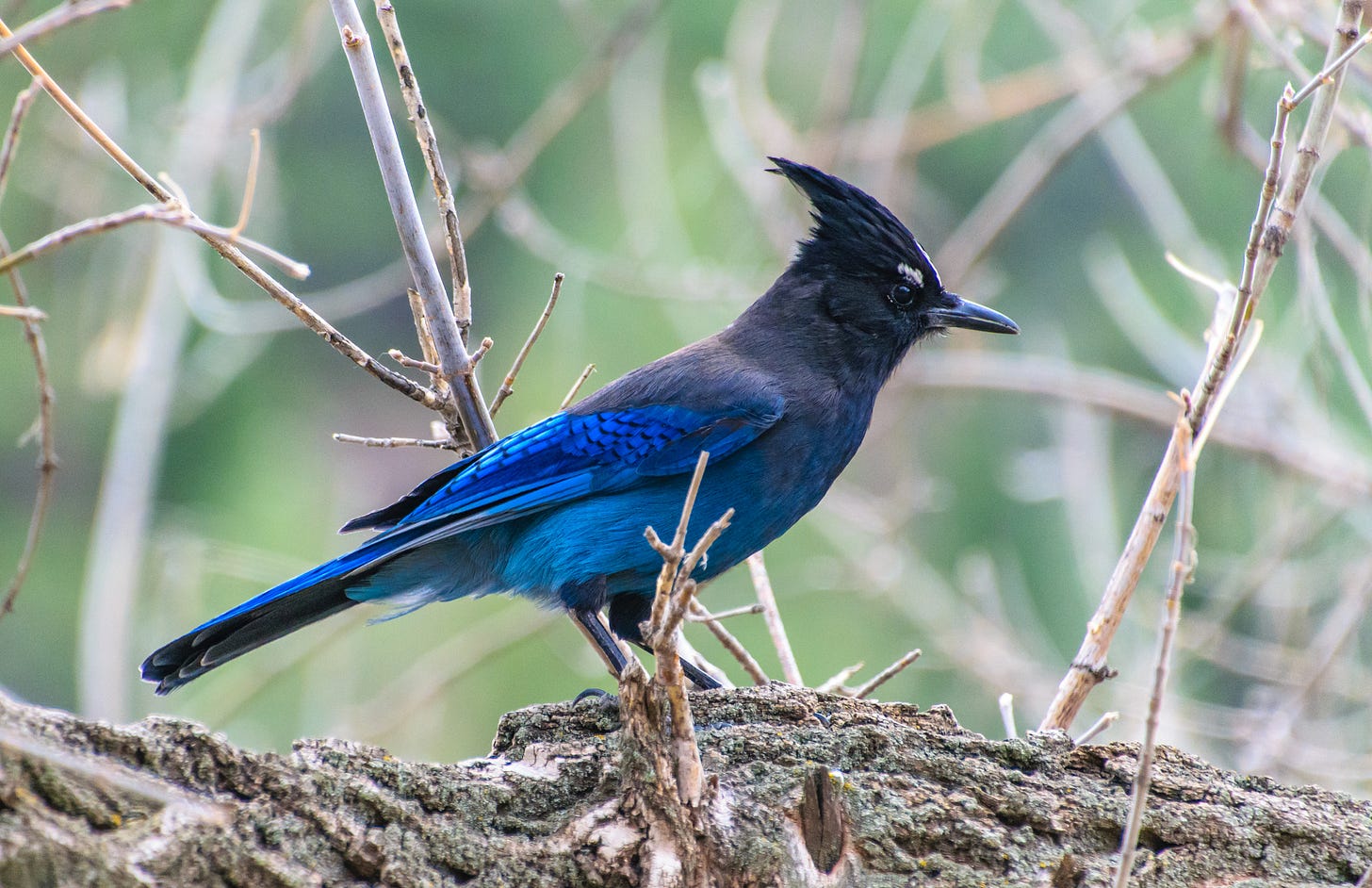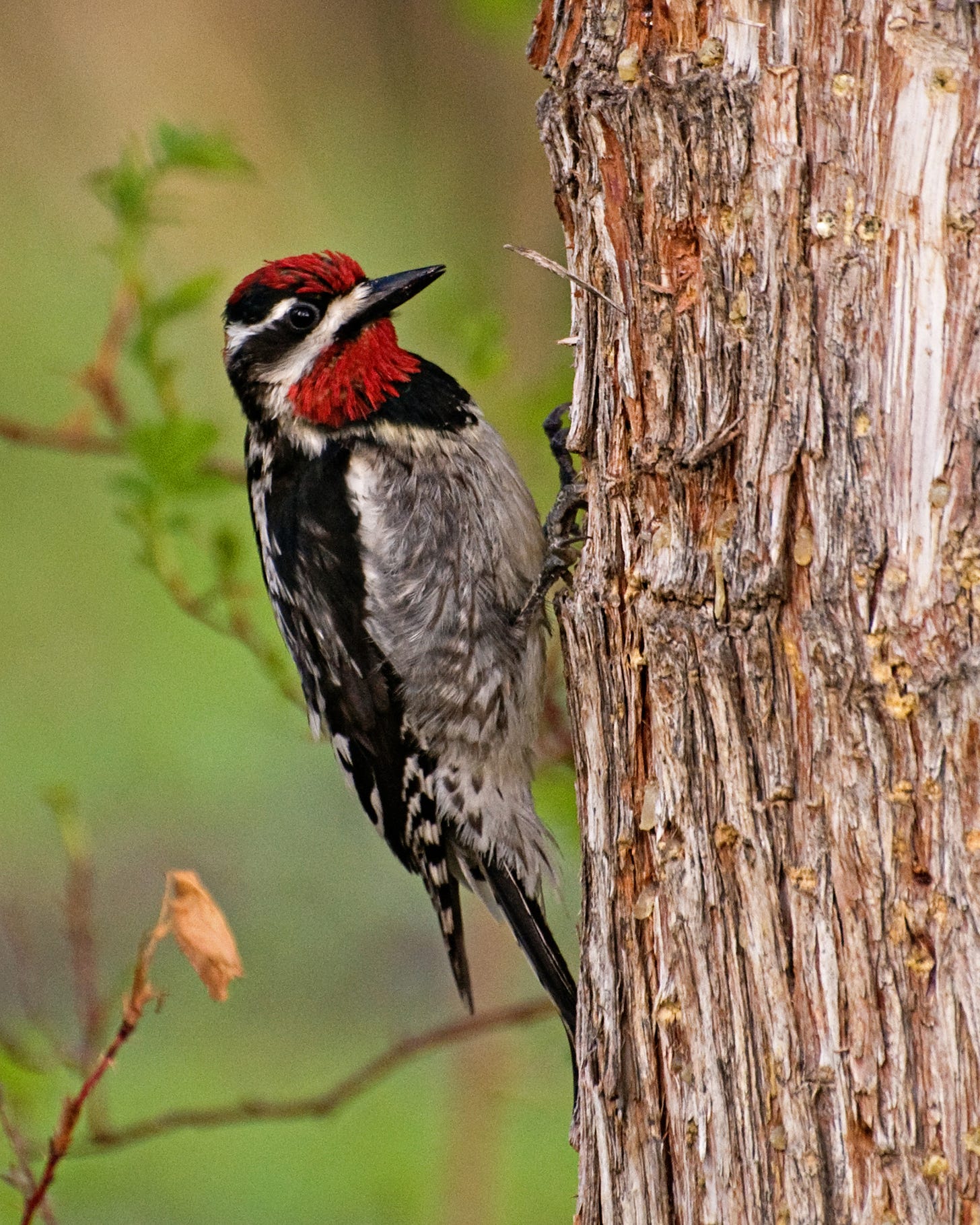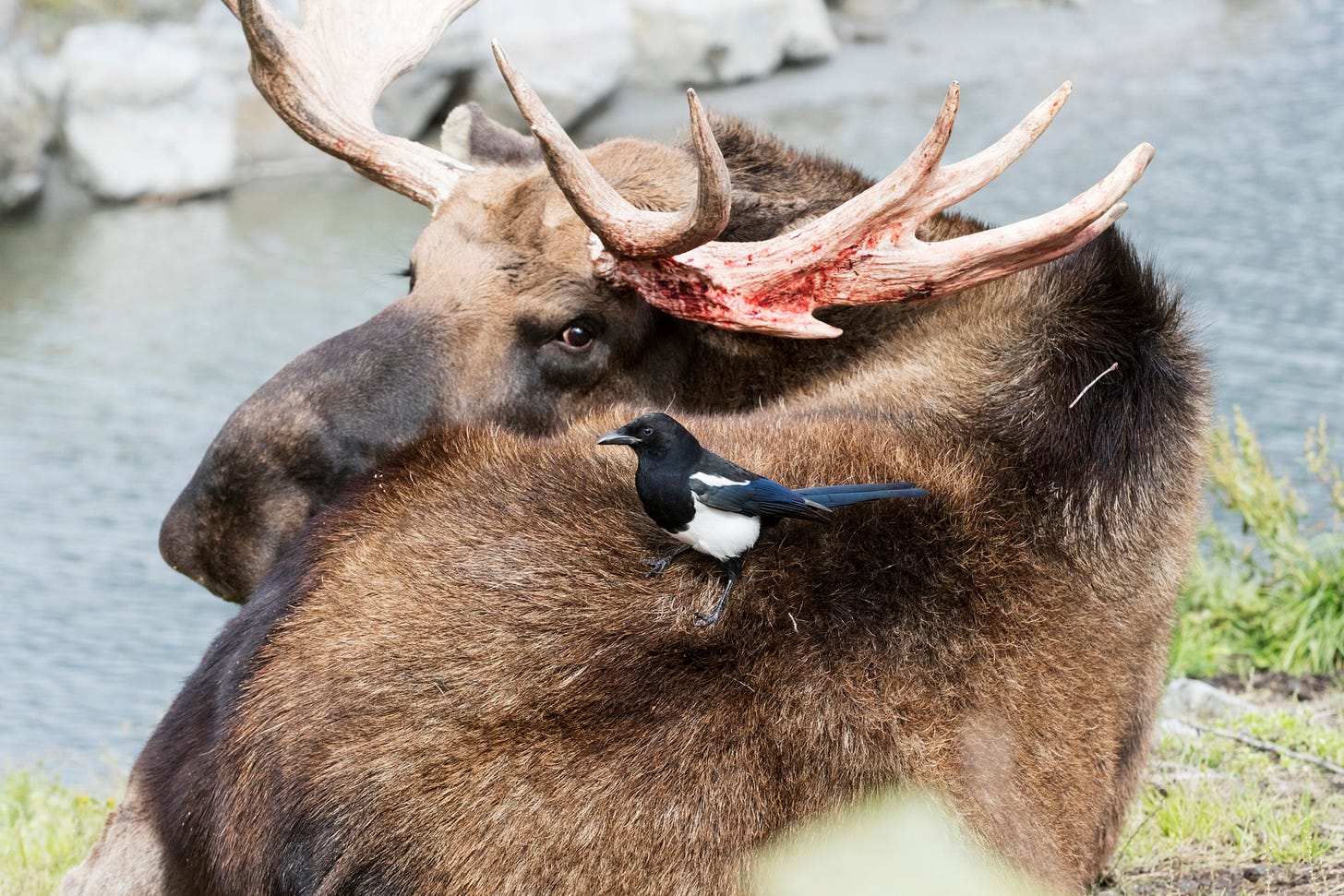For context on my relationship with birds, make sure to read last week’s issue of Shangrilogs.
In June 2021, I put my hands on the railing of my deck in the oak tree tops, and I sang an old song to the birds. I’d lived there six years, and we had a routine. I filled the feeders — one for the hummers, one for the orioles, one for the finches, and another for everyone else — and then I sang to them to tell them breakfast was ready.
That day was my last song. I cried, sealing in a new core memory, June2021_TopangaBirdsGoodbye, but they would be fine and so would I.
Birds don’t need feeders. In fact, we need birds more than they need us. Birds evolved long before humans, and most of them still have plenty to eat, assuming we can slow our continual assault on every ecosystem we show up in. We feed them for our own enjoyment. (And sometimes, for our own problems.)
When I said goodbye to Topanga, I was saying goodbye to the birds I’d spent years studying, feeding, watching, and loving. There are somewhere around 10,000 species of birds in the world (though hotly debated), and I knew about 45 of them very well. But when you know a few birds, you know more than you realize.
Earlier this year, in Nicaragua, a friend spotted a bird and I said it was some kind of swift. I didn’t know what kind, but it was obviously a swift. I explained the characteristics that give a swift away, whether in Central America or in Europe, and she glanced at me, suspicious.
“How do you know so much about birds?”
“It’s like cars. At the very basic level, you have sedans, SUVs, trucks, tractor trailers, convertibles, etc. So that’s like identifying a parrot versus an owl versus a songbird. And then say we’re looking at just trucks. You have short beds, long beds, 4-door, 2-door — and you also have Toyota, Nissan, Ford, GMC, etc. So if you’re looking at songbirds, you could use calls or shape or some other overarching characteristics to ID them. Say all warblers are Toyotas. Once you know the shape and logo of a typical Toyota, then it’s a Tacoma versus a Tundra, then it’s Tacoma TRD Sport versus a Tacoma TRD Off-Road, and when you’re really in deep you can start ID’ing off-market mods like specific light bars or Raptor grills. It’s the same with birds: eventually you just get narrower and narrower until you can identify the broad-strokes of any bird, whether it be by shape, territory, call, flight pattern, whatever. ”
“Wait, why do you know so much about cars?”
I don’t know anything about cars — but I can ID them.
And when we moved to Colorado, I didn’t know anything about its birds, but I could ID the basics. We had the usual corvid suspects: magpies, crows, ravens, stellar jays, and gray jays. We had one hummingbird who braved the altitude: broad-tailed. And some basic songbirds: American robin (thrush) and dark-eyed juncos (sparrow). Life at 10,000 feet isn’t always a walk in the park or a flutter in the sky. We don’t have a great nesting season at this altitude. The final snow storm of the season was on May 4. There isn’t as much food — it’s so cold for so long that we don’t have an abundance of insects. We also don’t have a great variety of trees up here. Just like not everyone wants to live in a cabin where it snows inside, not everyone wants to live in an Aspen tree, and fewer still want to live above the tree line. So if you’re looking for a bird watchers paradise, you gotta go lower.
Which is why I joined the local library earlier this month for a morning bird walk through the wet lands, about 1300 feet lower than my house. It was 21°F at 8:05am when I scurried up to a group of binocular-clad birders. We were going for a glacial stroll through the wet lands to spot who’d just arrived for the emergence of spring. While these birds are risking the weather with early migration, they’re also guaranteeing the best real estate. The early bird doesn’t just get the worm, they get the territory.
Birding, as a hobby, carries a lot of stereotypes. Snobby retirees traveling the world with their “Life List,” that it requires some level of National Geographic type patience, or my least favorite: that it’s boring. I challenge this sentiment and offer you this: any time you are outside doing anything, there are likely birds. Waiting outside a cafe for your friends to arrive for lunch? Birds. Walking to work? Birds. Sitting in the car waiting to pick up your kids? Birds. For me, birds are an escape from humans and from phones. If as a child you ever dreamed about fairies or imps or trolls, those are just birds. Mischievous aerial acrobats chanting and screaming, conspiring and constructing a world we all benefit from. They provide subscription-free access to my favorite soap opera. Moving from one region to another is like switching from Days Of Our Lives to General Hospital — different characters, same lunacy. So let’s meet some of the new cast.
Starting with the Stellar Jay, a truly stellar member of the corvid family.
You can find this punk rocker in most western American forests. They like a dense coniferous wood, and you’ll typically see a flock of them fly across a clearing one at a time, calling as they finish flight to perch in a tall pine. During nesting season, they actually become quite secretive, but they’ll throw a big ole fit if you get near their nest. If you hear a bird that makes you go, “jesus, that’s a rough call,” and it sounds like someone hacking on helium, that’s probably a jay. These birds are typically a year-round resident, but not up here. They head to fairer weather, but return late April/early May.
Next up, we’ve got the return of habitat-helpers, the Red-Naped Sapsucker.
Who doesn’t love a woodpecker? These guys can be found up and down the Rocky Mountains. Their drumming on trees sounds an awful lot like Morse Code, so keep your ears open for hidden messages on your next alpine hike. These guys love an Aspen tree. They drill tiny holes into the tree, returning to eat the sap, hence sapsucker. Both the male and female excavate the trees for nesting, and many times, after wintering in Mexico, they’ll return to the same tree year after year, sometimes even the same cavity. On our walk through the marsh, our lead birder pulled out his phone to play the drumming sound to see if anyone would respond in kind. No more than 60 seconds later, the male flew into one of the cottonwoods and drummed back. His coded message was pretty clear: “This is my fucking tree, go away.”
(A note on playing sounds from your phone to attract birds: those sounds are not just “songs.” They can be warnings of predators, negotiations in territory, desperate pleas for a mate before nesting season is up, or calls for help. Imagine falling into a gully and breaking your leg, and then a bird plays a sound of a human saying, “hang on, I’m coming!” and then no one comes. It’s not super nice!)
On May 6, our first hummer returned to 10,000 feet: the broad-tailed hummingbird.
One of my favorite things about hummingbirds is that you can actually learn to identify them by the sound of their wings. Like Anna’s Hummingbirds will have a more typical bzrrr sound, but Rufous hummers have a janglier sound, and this is because there is a V-shaped cut at the end of their wings that, at speed, creates different sounds based on its shape. The broad-tailed’s flight has metallic wing-trill, and if you find yourself in Utah, Arizona, western Colorado, New Mexico, or southern Idaho and Wyoming, now is the time to watch for his mating display. He’ll climb higher and higher into the air, getting some hundred feet high, and then dive bomb toward the ground before swooping up in a J-formation. Any Top Gun fans can appreciate.
We were lucky enough to see this display on our walk, but he wasn’t the only one putting on a show. American Dippers glided over the river ripples, Ruby-crowned Kinglets sang their little hearts out, Brewers Blackbirds and Red-winged Blackbirds shared the leaf-less aspens, Cinnamon Teals and Mallards dipped and dived around a beaver lodge, and on top of the lodge protected in the center of the pond, one very smart goose nestled on top, incubating her eggs.
But my favorite of all the birds, and a year-long resident at 10,000 ft, the magpie. The black-billed magpie is a fucking gift. Found across much of the western North America landscapes, this is a bird to make you love birds.
These birds are the coyotes of the sky: playful, chatty, clever, and successful at evading the decades-long assault of farmers and ranchers. It takes these birds 40 hours to build their nests, complete often with a dome and two entrances. They’ll eat just about anything, including other species’ eggs, ticks off of large mammals, and whatever they can steal from you. Magpies can also recognize themselves in the mirror. If a magpie befriends you, consider yourself lucky.
As all the birds migrate back to our valley, the air is filled with their falsettos and fables, highlighting just how barren winter was here. Birdsong has long indicated to our own species the presence of a life-sustaining environment. Deep in our biology, we are interlinked with birds announcing the morning, warning of threats, and singing of calm. There is a small aspen grove on the edge of our property with a rotting bench made of a halved tree trunk under it. I sit there with the cats on their leads and we three peer up into barren branches to see who new has arrived today. I take notes on the Northern Harrier, the Mountain Chickadee (whose hippocampus expands some 30% in volume in fall to remember where they stored all their caches!), the robins and juncos, the crows and ravens, the rare hawk flying above, because here, we cannot feed the birds. Here, we only watch, because it’s not just the birds that are coming back.
Starting in mid-March, black bears across Colorado start to leave their dens, ready to feed themselves and their families. With the ability to smell food from 5 miles away, filling a canister outside your house with yummy goodies like nuts and seeds is maybe not the best idea. Bird feeders are highly discouraged in bear country because what a bounty for a bear! A truly easy meal! That keeps getting refilled! Drawing a hungry bear toward your home is bad for you, but much, much worse for the bear. An exclusion to this rule is hummingbird feeders — you can still put those up.
(An aside: I will do a whole issue on bears, but I want to make it clear you are significantly more likely to die being attacked by a dog than you are by a bear. In the rare instances a bear has killed a human, it is because of the actions of countless other humans giving them food, leaving their trash unlocked, destroying their habitat, and in general, being fucking stupid.)
So how does a bird girl bird?
When birds migrate, they’re moving from areas of low or decreasing resources to areas of high or increasing resources, those resources being food and nesting locations. It makes sense: as winter rolls in, buds and flowers and insects start to disappear. It’s not the cold that drives them out, but everything else. Actually, many species including hummingbirds are perfectly fine in freezing temperatures so long as there’s enough to eat. Bird migration is truly incredible, and as new friends fly in, they don’t need the drive-thru version of seed. They need an environment that can sustain them long after their feeders stop being filled.
Time to restore an ecosystem.
It’s said the best way to approach a garden is to live somewhere for several years first so you can understand the weather patterns and potential setbacks. We’re closing in on completing one year here, and we inherited a sort-of hodgepodge garden. There’s a natural bird bath built into the center of the front yard. There are tiered gardens on the eastern side of the house, full of western mint and flowers. There are the aspens, a juniper bush, and a type of pine bush I haven’t identified yet. We spent the better part of last summer weeding out invasive species, and finished off the fall by sprinkling in native plant seeds hoping for a bountiful spring.
Beyond seeds and a watering hole, we’re creating insect and small animal refuges out of old, untreated wood scraps and logs, piled up around the yard. (If you’re interested in ‘Insect Hotels’ and the like, here’s a great piece on what works and what doesn’t.) And over the next two years, we’ll continue planting natural grasses and building upon the little ecosystem to ensure there’s a safe place to land. Because my friends the birds are in trouble.
Mountain birds are on what the Cornell Ornithology Lab calls “an escalator to extinction.”
As climate change warps ecosystems, high alpine environments are getting warmer and warmer, and some birds are running out of range. Ptarmigans, who turn white in the winter for camouflage, are sporting their new white feathers against completely brown backgrounds. In the Peruvian Andes, it’s likely at least four species have been extirpated already, including the variable antshrike, buff-browed foliage-gleaner, hazel-fronted pygmy-tyrant, and fulvous-breasted flatbill. They’re not threatened yet, but they have to move higher and higher to find the right environment.
Researchers the Cornell Lab of Ornithology (the best in the biz) found that habitat zones in Peru have shifted upslope over the past 30 years as temperatures have warmed, so the birds go up too – and they’re running out of mountain. The researchers estimate that as average temperatures warm as much as 3°F by the end of the century, tropical species can be expected to shift upslope by another 1,640 to 2,953 feet. That means a bird living in the Caribbean may need to climb some 2500 feet, and that rules out a lot of places to live.
Birds drop seeds helping forests grow, they spread fungi networks that keep our soil healthy and alive, they pollinate food crops, and they’re fucking beautiful. You do not need to be a birder to love birds. And you don’t need to know all 10,000 species to be an advocate to them. All you need to do is look up the birds in your area, read a little, and maybe download eBird.
Once, on a bluebird day in Topanga, I saw a bird I’d never seen before. It was obviously a grosbeak, but not the kind we usually saw. I took a photograph and a video, and opened my bird book. It was a Rose-breasted Grosbeak, common everywhere in North America east of the Rockies. What was it doing in California? I submitted my sighting to eBird, and they rejected it. “Unlikely.” So I challenged it, and ended up emailing with Kimball Garrett, the Ornithology Collections Manager at he Natural History Museum of Los Angeles County. I sent in my photos and video, and clear as day, it was a Rose-breasted Grosbeak well out of range. One bird is typically an anomaly. They got swept up in a storm or simply traveled off path. But many birds off path is an irruption. Irruptions can be natural, but they can also tell scientists things about climate change and ecosystem damage that are integral to protecting and saving species. And they often get this information because people report it.
By the time this newsletter is in your inbox, I’ll be closing out a birding trip of my own to Dominica to see the bounties of the jungle before they’re upsloped to somewhere else. In the comments below, I’d love to hear where you are in the world, and the birds you see day in and day out. They won’t always be there, and neither will we, so let’s enjoy the closest we have to fairies while we can. And if you see a grackle or a raven, tell them I said hi.










I'm sure everyone and their brother are going to congratulate you on this wonderful piece, so I'll tell you about the German children's song "Die Vogelhochzeit" (The Bird Wedding) instead. Every verse names a bird and what they bring to/make for the wedding. The translation (below) is horrible; most verses rhyme and fit the melody, but just so you get the idea. Anyway, don't know if I'm ready to be a birder but I LOVE BIRDS. There, I said it. https://lyricstranslate.com/en/vogelhochzeit-bird-wedding.html
Hokay, so, I'm using my long holiday weekend to catch up on my backlog of unread newsletters, and I'm both so glad I'm reading this now and so annoyed that I didn't read it earlier. 'If you hear a bird that makes you go, “jesus, that’s a rough call,” and it sounds like someone hacking on helium, that’s probably a jay.' - I literally LOLd. I haven't even gotten to the magpie section - truly the most magical birds here - I just had to leave a comment mid-read. Thanks for writing (this and all the other things)! Yay birds!